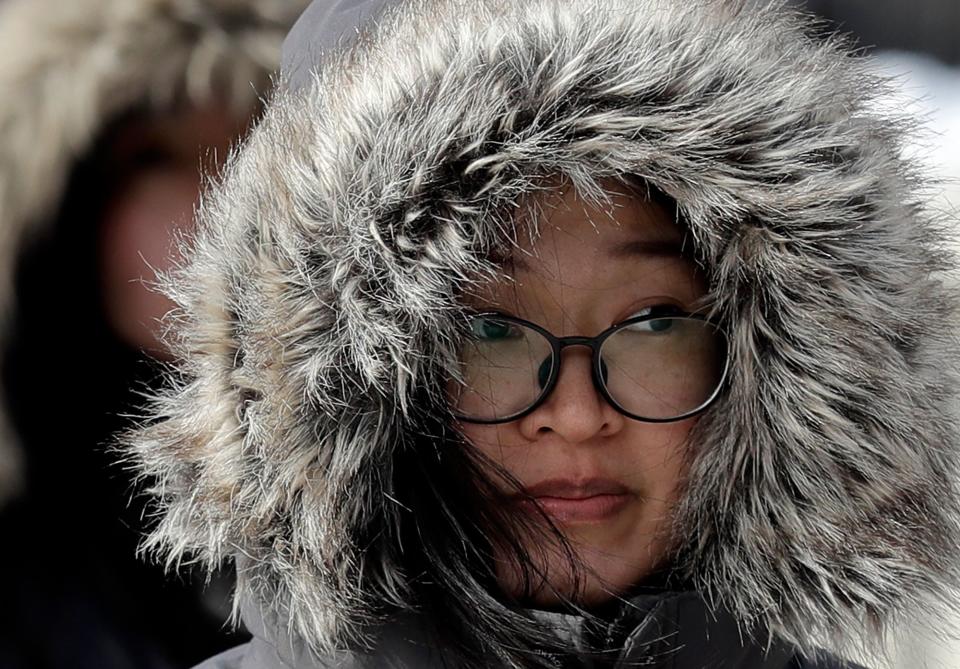Here are the facts: Despite winter storms, global warming is real
Weather and climate: They just aren't the same things.
Extreme cold, big snowstorms – and even unwelcome invasions from the polar vortex – will continue to hit the U.S., even as humans continue to warm the planet.
As he has several times in the past, President Donald Trump again tweeted about global warming during a cold snap: Late Monday, he tweeted that "in the beautiful Midwest, windchill temperatures are reaching minus 60 degrees, the coldest ever recorded...What the hell is going on with Global Warming? Please come back fast, we need you!"
However, no matter how much humans have warmed the planet, we still didn't kill winter: Trump's own federal agency – the National Oceanic and Atmospheric Administration – corrected the president on Tuesday, noting that "winter storms don't prove that global warming isn't happening."
Indeed, while temperatures in the Midwest are nearing all-time record lows, the U.S. as a whole covers only about 2 percent of the Earth's surface.
"One snowstorm over the U.S East Coast does not invalidate decades of observations around the entire world showing that yes, the planet is warming," Texas Tech climate scientist Katherine Hayhoe said.

And despite this week's chill, the four years from 2015 to 2018 were Earth's warmest four years in recorded history, according to NOAA. In addition, global temperatures have been above average for the past 407 consecutive months.
"We live in and share a world that is unequivocally, appreciably and consequentially warmer than just a few decades ago, and our world continues to warm," NOAA climate scientist Deke Arndt said last year.
More: Chicago will be colder than Antarctica this week; 250 million in U.S. will see freezing temperatures
More: Icy cold of the vortex lays waste to plans, closing city halls, schools, zoos across US
Human-caused global warming happens when fossil fuels such as coal, oil and gas are burned, releasing greenhouse gases such as carbon dioxide into Earth's atmosphere and oceans. This has caused the planet to warm to levels that scientists say cannot be explained by natural factors, the National Climate Assessment said last year.
"People also tend to confuse what is happening where they live as an indication of what is happening globally," University of Georgia meteorologist Marshall Shepherd told CNN.
The world as a whole on Monday was 0.7 degrees warmer than the 1979-2000 average, according to the University of Maine’s Climate Reanalyzer.
"Yes, it's cold in the U.S. Midwest and parts of Canada," noted meteorologist Steve Bowen of insurance firm Aon. "But, overall, the globe is still anomalously warm."
Indeed, some places such as Australia have seen record warmth in the past couple of weeks as temperatures soared to a broiling 120 degrees.
Some scientists – but not all – say there could be a connection between global warming and the wandering polar vortex: The theory is that when weird warmth invades the Arctic, some of the cold that's supposed to stay up there – including the vortex – instead sloshes down south into North America and Europe.

"There’s growing evidence that a warming Arctic drives the polar vortex," University of Maine ecologist Jacqueline Gill said Tuesday.
Woods Hole Research Center climate scientist Jennifer Francis, who published a study on the phenomenon last year, said that "warm temperatures in the Arctic cause the jet stream to take these wild swings, and when it swings farther south, that causes cold air to reach farther south."
The jet stream is the river of air up in the atmosphere that steers weather around. A 2015 study in the journal Science reported that the rapid warming of the Arctic is making for a more wavy jet stream, with waves that move more slowly across the globe.
And when it gets wavy, cold Arctic air sometimes pours down over the U.S.
A 2018 study in the Bulletin of the American Meteorological Society, co-authored by Atmospheric Environmental Research meteorologist Judah Cohen, found that "over recent decades, the stratospheric polar vortex has shifted toward more frequent weak states," allowing it to stray from its home above the North Pole.
Other scientists – such University of Oklahoma meteorology professor Jason Furtado – aren't sold on the climate change connection.
Another expert, weather.us meteorologist Ryan Maue, said last year that "no firm scientific consensus exists in the climate community on these Arctic 'extreme' interactions." But he said that Francis' study "will help direct future research and spur timely debate on a high-impact climate-change problem."
Contributing: The Associated Press
This article originally appeared on USA TODAY: Here are the facts: Despite winter storms, global warming is real

